2011管理学课后作业答题要点
管理学简答题答案(重点)

1、有效率的组织一定是有效果的吗?为什么?答:不一定。
管理就是要使资源成本最小化。
所以仅仅有效率是不够的,管理还必须使活动实现预定的目标,即追求活动的效果。
当管理者实现了组织的目标,我们就说他们的工作是有效果的。
因此,效率涉及的是活动的方式,而效果涉及的是活动的结果。
效率和效果是互相联系的,组织可能是有效率但却是无效果的,那种要把错事干好的组织就是如此。
2、管理的基本职能有哪些?答:管理作为一个工作过程,管理者在其中要发挥的作用就是管理者的职能,也即通常所说的管理职能。
而管理的基本职能就是管理工作所包括的几类基本活动内容,即计划、组织、领导、控制和创新。
3、管理者在一个组织中担当什么角色?答:亨利?明茨伯格把管理者角色分成3大类10个角色。
4、在对基层管理者的技能要求中,为什么技术技能最重要?答:基层管理者需要了解并初步掌握与其管理的专业领域相关的基本技能,否则就很难与他所主管的组织内的专业技术人员及其他人员进行有效的沟通,从而也就无法对他所管辖的业务范围内的各项管理工作进行具体的指导。
5、在对高层管理者的技能要求中,为什么概念技能最重要?答:概念技能包括理解事物的相互关联性从而找出关键影响因素的能力、确定和协调各方面关系的能力以及权衡不同方案优劣和内在风险的能力等等。
显然,任何管理者都会面临一些混乱而复杂的环境,需要认清各种因素之问的相互联系,以便抓住问题的实质,根据形势和问题果断地做出正确的决策。
因此,管理者所处的层次越高,其面临的问题越复杂、越无先例可循,就越需要概念技能。
6、供应商是如何对企业产生影响的?答:供应商对企业的影响表现在两个方面:一是供应商能否按照企业的需求按时、按质、按量地提供各种要素,这决定了生产经营活动能否正常运行;二是供应商的价格谈判能力,这决定了企业的生产经营成本并进一步影响企业的利润水平。
7、简述组织环境的分类?答:组织环境包括一般环境和具体环境。
一般环境包括组织外的一切,如全球环境、政治环境、政治/法律环境、社会文化环境及技术环境,还包括那些能影响组织但联系尚不清楚的条件。
管理学简答题(已完成)
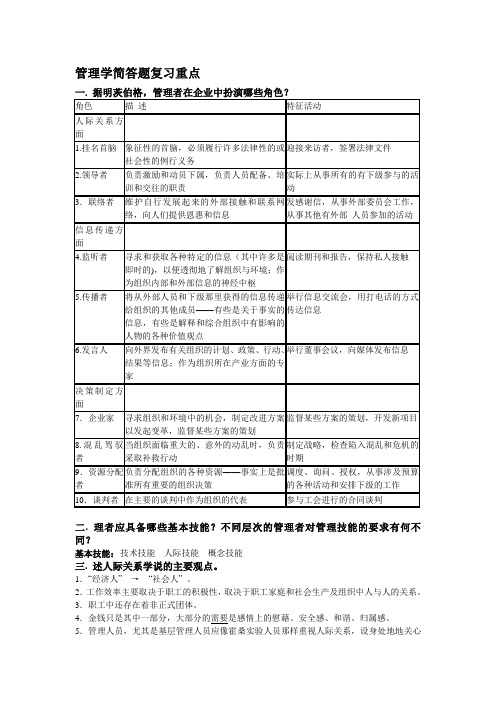
管理学简答题复习重点二. 理者应具备哪些基本技能?不同层次的管理者对管理技能的要求有何不同?基本技能:技术技能人际技能概念技能三. 述人际关系学说的主要观点。
1.“经济人”→“社会人”。
2.工作效率主要取决于职工的积极性,取决于职工家庭和社会生产及组织中人与人的关系。
3.职工中还存在着非正式团体。
4.金钱只是其中一部分,大部分的需要是感情上的慰藉、安全感、和谐、归属感。
5.管理人员,尤其是基层管理人员应像霍桑实验人员那样重视人际关系,设身处地地关心下属,通过积极的意见交流,达到感情的上下沟通。
四. 什么是经营战略?它具有哪些特征?五. 简述决策的含义及决策的一般步骤。
(一)决策的含义决策理论认为,决策是为了实现某一目的而从若干个可行方案中选择一个满意方案的分析判断过程。
决策的含义实际包含了以下几方面的内容:1. 决策要有明确的目的决策或是为了解决某个问题,或是为了实现一定的目标。
没有目标就无从决策,没有问题则无需决策。
在决策时:要解决的问题必须十分明确,要达到的目标必须有一定标准可资衡量比较。
2. 决策要有若干可行的备选方案一个方案无从比较其优劣,也无选择的余地。
“多方案抉择”是科学决策的重要原则3. 决策是一个对方案进行分析判断的过程每个可行方案都有其可取之处,也有其不利的一面。
必须对每个备择方案进行综合的分析与评价,以比较各方案的优劣。
4. 决策的结果是选择一个满意的方案最优方案既不经济又不可行,科学决策遵循的是满意原则。
满意方案:在诸多方案中,在现实条件下,能够使主要目标得以实现,其它次要目标也足够好的合理方案。
⒌决策是一个分析判断过程。
决策有一定的程序和规则,但它又受诸多价值观念和决策者经验的影响。
对同一个问题不同的人有不同的决策结果,是正常的现象。
管理者要作出科学的决策,就必须不断提高自己的决策能力。
6. 决策是管理者从事管理工作的基础决策是管理者从事管理工作的基础,是衡量管理者水平高低的重要标志之一,在管理活动中具有重要的地位与作用。
管理学答题技巧
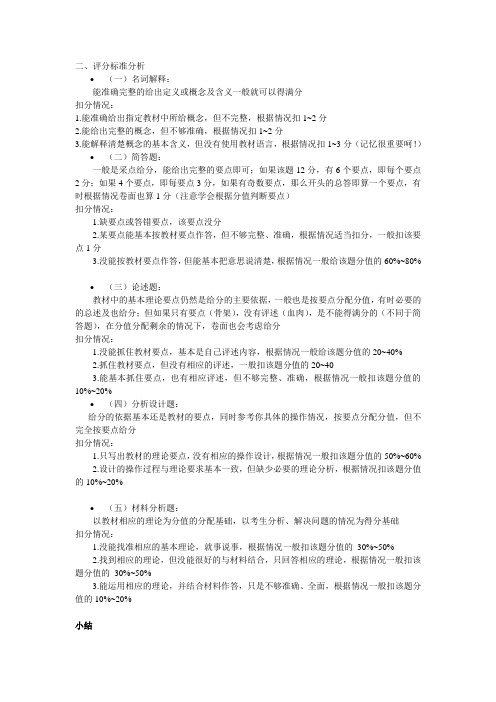
二、评分标准分析•(一)名词解释:能准确完整的给出定义或概念及含义一般就可以得满分扣分情况:1.能准确给出指定教材中所给概念,但不完整,根据情况扣1~2分2.能给出完整的概念,但不够准确,根据情况扣1~2分3.能解释清楚概念的基本含义,但没有使用教材语言,根据情况扣1~3分(记忆很重要呵!)•(二)简答题:一般是采点给分,能给出完整的要点即可;如果该题12分,有6个要点,即每个要点2分;如果4个要点,即每要点3分,如果有奇数要点,那么开头的总答即算一个要点,有时根据情况卷面也算1分(注意学会根据分值判断要点)扣分情况:1.缺要点或答错要点,该要点没分2.某要点能基本按教材要点作答,但不够完整、准确,根据情况适当扣分,一般扣该要点1分3.没能按教材要点作答,但能基本把意思说清楚,根据情况一般给该题分值的60%~80%•(三)论述题:教材中的基本理论要点仍然是给分的主要依据,一般也是按要点分配分值,有时必要的的总述及也给分;但如果只有要点(骨架),没有评述(血肉),是不能得满分的(不同于简答题),在分值分配剩余的情况下,卷面也会考虑给分扣分情况:1.没能抓住教材要点,基本是自己评述内容,根据情况一般给该题分值的20~40%2.抓住教材要点,但没有相应的评述,一般扣该题分值的20~403.能基本抓住要点,也有相应评述,但不够完整、准确,根据情况一般扣该题分值的10%~20%•(四)分析设计题:给分的依据基本还是教材的要点,同时参考你具体的操作情况,按要点分配分值,但不完全按要点给分扣分情况:1.只写出教材的理论要点,没有相应的操作设计,根据情况一般扣该题分值的50%~60%2.设计的操作过程与理论要求基本一致,但缺少必要的理论分析,根据情况扣该题分值的10%~20%•(五)材料分析题:以教材相应的理论为分值的分配基础,以考生分析、解决问题的情况为得分基础扣分情况:1.没能找准相应的基本理论,就事说事,根据情况一般扣该题分值的30%~50%2.找到相应的理论,但没能很好的与材料结合,只回答相应的理论,根据情况一般扣该题分值的30%~50%3.能运用相应的理论,并结合材料作答,只是不够准确、全面,根据情况一般扣该题分值的10%~20%小结• 1.名词解释、简答题,记忆书本知识是关键,紧贴书本记准、答全是得分的关键• 2.设计题、论述题、案例分析题,找准相应的理论要点是前提,理论联系实际解决问题是关键;同时,答题的逻辑性、条理性及书面情况是得高分的关键(一般评分时不会拘泥于参考答案,具有很强的主观色彩)•三、答题技巧•(一)名词解释题:1.定义型(教材中有明确定义):紧贴教材,完整、准确答出其定义。
管理学试题及答题方法

管理学试题及答题方法管理学试题的题型有简述题、选择题、案例题和分析题,各种题型从不同角度测试考生对管理知识的掌握和运用程度。
简述题的解题方法简述题是直接测试考生对管理理论掌握程度的题型,所考问题一般均为基本管理知识(一个概念、一种定义的扩展),以及一些经济生活中出现和发生的问题。
在简述题部分很少利用管理知识去分析或论述一个问题,因此,要正确回答简述题,考生必须能全面地把据有关的基本概念、基本原则和基本方法,并能正确和全面地表述所涉及的管理知识的基本内容和道理。
简述题在整张管理学考卷分值中的比重为20%。
因此,所测试的内容多为基本管理知识。
但随着管理学试题越来越具灵活性来看,考生应该对管理学的4个职能各自所包含的基本内容有明确的记忆,并能够系统地、综合地通过认真审题来作答。
2001年10月份所考的简述题基本上都倾向于灵活题,并呈现以下特点:简述题涉及内容更全面,不是考单一管理职能知识掌握,而是考管理综合职能及相关知识掌握。
简述题的审题难度加大,如不注意往往造成答非所问。
简述题在答题时应删繁就简。
在审清题目后只需答出要点即可,对每个要点无需作过多的展开。
在要点较多时,甚至无需展开要点。
为便于试卷的批改,考生在回答简答题时,可考虑将要点明确地加以标注。
因此,只要对所考知识较为熟悉,就可以顺利作答,而且耗费的时间不多。
有些考生把简述题混同于论述题,针对所问,知无不言,言无不尽,以为这样能得高分。
但实际上阅卷老师是按要点给分,只要答出要点,即使答得简练也得分;答得再多,苦未提到要点也无法得分,而且徒然浪费了宝贵的时间,影响后面题目的解答,尤其是使占分较多、答案不甚明了的选择题和案例题不能从容应答。
‘简洁正确地回答简述题除了需要考生考前认真仔细复习外,还需要掌握一定的答题技巧(二)简述题应答程序、技巧、规则.(1)不能轻视审题,认为题干很简单,一看便知,匆忙回答。
从阅卷看约有30%的同学犯有审题不明,边答边想,结果字写了不少,答题空间不够了击中要害,踩不到得分要点。
公共课(管理学)作业及答案(2011-2012)
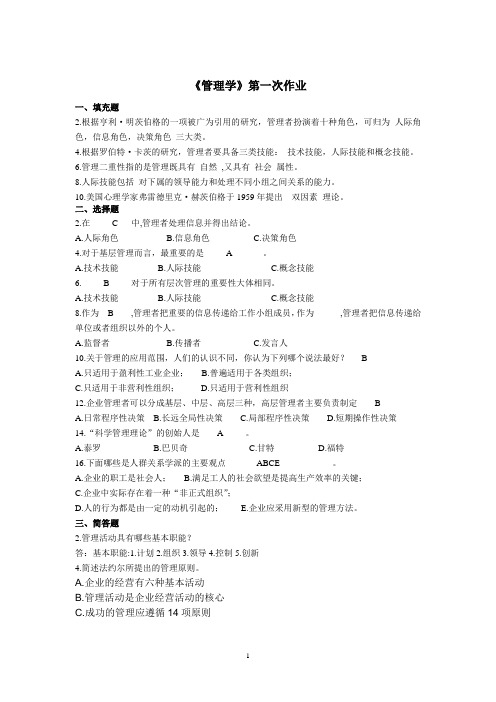
《管理学》第一次作业一、填充题2.根据亨利·明茨伯格的一项被广为引用的研究,管理者扮演着十种角色,可归为_人际角色,信息角色,决策角色_三大类。
4.根据罗伯特·卡茨的研究,管理者要具备三类技能:_技术技能,人际技能和概念技能。
6.管理二重性指的是管理既具有_自然,又具有_社会_属性。
8.人际技能包括_对下属的领导能力和处理不同小组之间关系的能力。
10.美国心理学家弗雷德里克·赫茨伯格于1959年提出__双因素_理论。
二、选择题2.在_____C___中,管理者处理信息并得出结论。
A.人际角色B.信息角色C.决策角色4.对于基层管理而言,最重要的是_____A_______。
A.技术技能B.人际技能C.概念技能6._____B_____对于所有层次管理的重要性大体相同。
A.技术技能B.人际技能C.概念技能8.作为__B____,管理者把重要的信息传递给工作小组成员,作为______,管理者把信息传递给单位或者组织以外的个人。
A.监督者B.传播者C.发言人10.关于管理的应用范围,人们的认识不同,你认为下列哪个说法最好?___B______A.只适用于盈利性工业企业;B.普遍适用于各类组织;C.只适用于非营利性组织;D.只适用于营利性组织12.企业管理者可以分成基层、中层、高层三种,高层管理者主要负责制定____B_____A.日常程序性决策B.长远全局性决策C.局部程序性决策D.短期操作性决策14.“科学管理理论”的创始人是____A_____。
A.泰罗B.巴贝奇C.甘特D.福特16.下面哪些是人群关系学派的主要观点_______ABCE____________。
A.企业的职工是社会人;B.满足工人的社会欲望是提高生产效率的关键;C.企业中实际存在着一种“非正式组织”;D.人的行为都是由一定的动机引起的;E.企业应采用新型的管理方法。
三、简答题2.管理活动具有哪些基本职能?答:基本职能:1.计划2.组织3.领导4.控制5.创新4.简述法约尔所提出的管理原则。
管理学课后习题答案
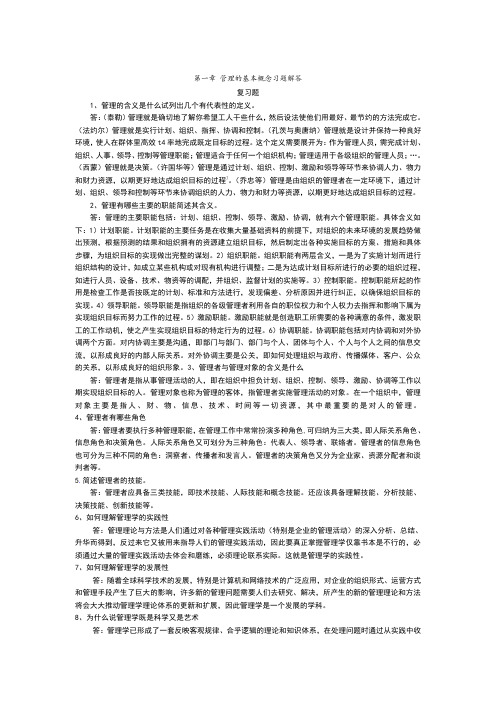
第一章管理的基本概念习题解答复习题1、管理的含义是什么试列出几个有代表性的定义。
答:(泰勒)管理就是确切地了解你希望工人干些什么,然后设法使他们用最好、最节约的方法完成它。
(法约尔)管理就是实行计划、组织、指挥、协调和控制。
(孔茨与奥唐纳)管理就是设计并保持一种良好环境,使人在群体里高效t4率地完成既定目标的过程。
这个定义需要展开为:作为管理人员,需完成计划、组织、人事、领导、控制等管理职能;管理适合于任何一个组织机构;管理适用于各级组织的管理人员;…。
(西蒙)管理就是决策。
(许国华等)管理是通过计划、组织、控制、激励和领导等环节来协调人力、物力和财力资源,以期更好地达成组织目标的过程]。
(乔忠等)管理是由组织的管理者在一定环境下,通过计划、组织、领导和控制等环节来协调组织的人力、物力和财力等资源,以期更好地达成组织目标的过程。
2、管理有哪些主要的职能简述其含义。
答:管理的主要职能包括:计划、组织、控制、领导、激励、协调,就有六个管理职能。
具体含义如下:1)计划职能。
计划职能的主要任务是在收集大量基础资料的前提下,对组织的未来环境的发展趋势做出预测,根据预测的结果和组织拥有的资源建立组织目标,然后制定出各种实施目标的方案、措施和具体步骤,为组织目标的实现做出完整的谋划。
2)组织职能。
组织职能有两层含义,一是为了实施计划而进行组织结构的设计,如成立某些机构或对现有机构进行调整;二是为达成计划目标所进行的必要的组织过程,如进行人员、设备、技术、物资等的调配,并组织、监督计划的实施等。
3)控制职能。
控制职能所起的作用是检查工作是否按既定的计划、标准和方法进行,发现偏差、分析原因并进行纠正,以确保组织目标的实现。
4)领导职能。
领导职能是指组织的各级管理者利用各自的职位权力和个人权力去指挥和影响下属为实现组织目标而努力工作的过程。
5)激励职能。
激励职能就是创造职工所需要的各种满意的条件,激发职工的工作动机,使之产生实现组织目标的特定行为的过程。
公共课(管理学)作业及答案(2011-2012)

《管理学》第一次作业一、填充题2.根据亨利·明茨伯格的一项被广为引用的研究,管理者扮演着十种角色,可归为_人际角色,信息角色,决策角色_三大类。
4.根据罗伯特·卡茨的研究,管理者要具备三类技能:_技术技能,人际技能和概念技能。
6.管理二重性指的是管理既具有_自然,又具有_社会_属性。
8.人际技能包括_对下属的领导能力和处理不同小组之间关系的能力。
10.美国心理学家弗雷德里克·赫茨伯格于1959年提出__双因素_理论。
二、选择题2.在_____C___中,管理者处理信息并得出结论。
A.人际角色B.信息角色C.决策角色4.对于基层管理而言,最重要的是_____A_______。
A.技术技能B.人际技能C.概念技能6._____B_____对于所有层次管理的重要性大体相同。
A.技术技能B.人际技能C.概念技能8.作为__B____,管理者把重要的信息传递给工作小组成员,作为______,管理者把信息传递给单位或者组织以外的个人。
A.监督者B.传播者C.发言人10.关于管理的应用范围,人们的认识不同,你认为下列哪个说法最好?___B______A.只适用于盈利性工业企业;B.普遍适用于各类组织;C.只适用于非营利性组织;D.只适用于营利性组织12.企业管理者可以分成基层、中层、高层三种,高层管理者主要负责制定____B_____A.日常程序性决策B.长远全局性决策C.局部程序性决策D.短期操作性决策14.“科学管理理论”的创始人是____A_____。
A.泰罗B.巴贝奇C.甘特D.福特16.下面哪些是人群关系学派的主要观点_______ABCE____________。
A.企业的职工是社会人;B.满足工人的社会欲望是提高生产效率的关键;C.企业中实际存在着一种“非正式组织”;D.人的行为都是由一定的动机引起的;E.企业应采用新型的管理方法。
三、简答题2.管理活动具有哪些基本职能?答:基本职能:1.计划2.组织3.领导4.控制5.创新4.简述法约尔所提出的管理原则。
管理学答题技巧
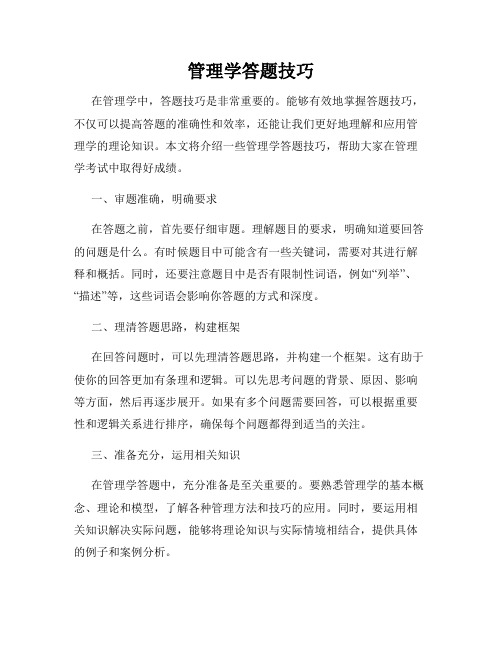
管理学答题技巧在管理学中,答题技巧是非常重要的。
能够有效地掌握答题技巧,不仅可以提高答题的准确性和效率,还能让我们更好地理解和应用管理学的理论知识。
本文将介绍一些管理学答题技巧,帮助大家在管理学考试中取得好成绩。
一、审题准确,明确要求在答题之前,首先要仔细审题。
理解题目的要求,明确知道要回答的问题是什么。
有时候题目中可能含有一些关键词,需要对其进行解释和概括。
同时,还要注意题目中是否有限制性词语,例如“列举”、“描述”等,这些词语会影响你答题的方式和深度。
二、理清答题思路,构建框架在回答问题时,可以先理清答题思路,并构建一个框架。
这有助于使你的回答更加有条理和逻辑。
可以先思考问题的背景、原因、影响等方面,然后再逐步展开。
如果有多个问题需要回答,可以根据重要性和逻辑关系进行排序,确保每个问题都得到适当的关注。
三、准备充分,运用相关知识在管理学答题中,充分准备是至关重要的。
要熟悉管理学的基本概念、理论和模型,了解各种管理方法和技巧的应用。
同时,要运用相关知识解决实际问题,能够将理论知识与实际情境相结合,提供具体的例子和案例分析。
四、重点突出,言之有物在答题时,要注意突出重点,言之有物。
可以通过加粗、下划线或其他方式来标记重点内容,使阅卷老师能够更加明确地看到你的观点和论据。
此外,要避免使用一些形容词或空洞的词语,而要运用具体的事实和数据来支持你的论述。
五、论述清晰,逻辑严谨在答题中,论述要清晰,逻辑要严谨。
每个观点和论据应该有明确的陈述,相互之间应该有连贯的关系。
可以通过使用过渡词语和段落的连接词语来保持句子和段落之间的连贯性。
此外,要注意论述的层次感,将主题和次要观点有机地组织在一起。
六、举一反三,融会贯通在回答问题时,要善于举一反三,融会贯通。
不仅要回答问题本身,还要将相关的理论和现实情境相结合,进行更广泛的思考和观察。
这有助于提高你的分析和判断能力,以及对管理学知识的深入理解。
七、简明扼要,节约用词在答题中,要以简明扼要为原则,节约用词。
管理学-各个题型的答题技巧

各个题型的答题技巧对于填空,填空的分值一般是1到2分一空,只有一个问题,那就是罗和刑的书上很多表述不一样,以谁的为准的问题,我们们的经验是看题干是谁书中的原话,就照谁的答。
如果题干一样,邢的说法和罗宾斯的说法有冲突,以罗的为主,但用邢的说法,老师也不会算你错,这是辅导老师的原话。
对于名词解释,同样有一个问题,那就是罗和刑的书上很多表述不一样,以谁的为准的问题,处理方法是只要2个人说的不对立,而每个人说的又不多那就都写上,组合一下,肯定没错。
比如“动机”,2人说的就不一样,可以这样答:动机是鼓励和引导人为实现某一目标而行动的内在力量,是个体通过高水平的努力而实现组织目标的愿望,而这种努力应能满足个体的某种需要。
它是人与环境的互动结果。
因此动机水平不仅因人而异,而且因时而异。
动机形成的根本原因是内在的未满足的需要;形成的条件有内在的需要和外部的诱导刺激。
分数在3到4分,所以字数要适当多一些,一般写三四行,对词条的解释核心部分要答准确,一般占2行,外延补充简明扼要,点到为止。
比如,“组织文化”,要先答核心:它是处在一定文化背景下的组织,在长期的发展过程中逐步形成的日趋稳定的独特的组织内部共享的价值观体系,并以价值观为核心形成的行为规范道德准则等。
外延补充:组织文化的来源是创始人的倾向性假设;和第一批成员从自己的经验中领悟到的东西。
其特点有客观性,个异性,民族性,稳定性。
再如,考试频率最高的一个“管理跨度”,就要先答核心:管理跨度是一位管理者能够有效地指挥的下属的数目。
外延补充:管理跨度的权变因素有:下属受过良好训练,下属工作任务的复杂性,下属工作使用标准程序的程度,组织管理信息系统的先进程度,组织文化的凝聚力,以及管理者的管理风格等。
现代组织理论认为应该加大管理跨度,减少组织层次使组织扁平化以提高效率。
对于简述,分值一般为6到10分,因为是简单叙述,你要记住,与其在一个方面说很多,不如从几个方面多说几点,并在每一点前面加标数字123,遇到不知道答的,即使你明明3句话是一个意思,你也可以标个123点,糊弄一下,因为管理本来弹性就大,你就认为是不同的方面,他也没办法,反而会因为看到你标的点多而多给点分。
管理学课后答案.doc

第一章管理活动与管理概论1.何谓管理?如何理解管理的具体含义?管理师指组织为了达到个人无法实现的目标,通过各项职能活动,合理分配、协调相关资源的过程。
(1)管理的载体是组织。
(2)管理的本质是合理分配和协调各种资源的过程,而不是其他。
(3)管理的对象是相关资源,即包括人力资源在内的一切可以调用的资源。
(4)管理的职能活动包括信息、决策、计划、组织、领导、控制和创新。
(5)管理的目标是为了实现既定的目标,而该目标仅凭单个人的力量是无法实现的,这也是建立组织的原因。
2.组织中的管理通常包括哪些职能活动?每种职能活动是如何表现其存在的?它们的相互关系又是如何?(1)决策:通过方案的产生和选择以及通过计划的制定表现出来。
(2)组织:通过组织结构的设计和人员的配备表现出来。
(3)领导:通过领导者和被领导者的关系表现出来。
(4)控制:通过对偏差的识别和纠正表现出来。
(5)创新:通过组织提供的服务或产品的更新和完善以及其他管理职能的变革和改进来表现其存在的。
相互关系:( 1)决策是计划的前提,计划是决策的逻辑延续。
(2)组织、领导和控制旨在保证决策的顺利实施。
(3)创新贯穿于各种管理职能和各个组织层次之中。
3.根据明茨伯格的研究,管理者应扮演哪些角色?人际角色:代表人角色、领导者角色和联络者角色。
信息角色:监督者、传播者和发言人角色。
决策角色:企业家角色、冲突管理者、资源分配者和谈判者角色。
4.根据卡茨的研究,管理者应具备哪些基本职能?技术技能、人际技能和概念技能。
5.简述中外早期管理思想,并对之进行简要评价。
中国:( 1)春秋,孙武《孙子兵法》,具有相当的指导意义和参考价值。
(2)战国,《周礼》对封建国家的经济管理的论述和设计都达到了相当高的水平。
(3)战国,孙膑运用统筹学和对策论的思想,帮助田忌在赛马中胜了齐王。
(4)《墨子》、《老子》、《管子》、《齐民要术》、《天工开物》等。
外国:( 1)亚当·斯密的劳动分工观点和经纪人观点。
(完整版)管理学课后答案
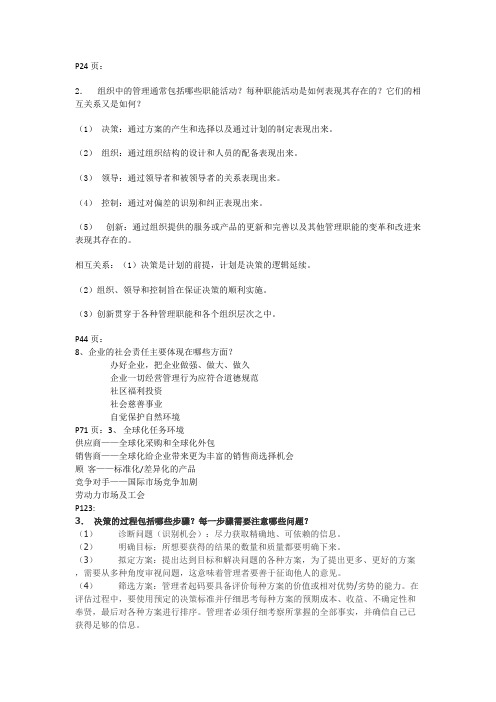
P24页:2.组织中的管理通常包括哪些职能活动?每种职能活动是如何表现其存在的?它们的相互关系又是如何?(1)决策:通过方案的产生和选择以及通过计划的制定表现出来。
(2)组织:通过组织结构的设计和人员的配备表现出来。
(3)领导:通过领导者和被领导者的关系表现出来。
(4)控制:通过对偏差的识别和纠正表现出来。
(5)创新:通过组织提供的服务或产品的更新和完善以及其他管理职能的变革和改进来表现其存在的。
相互关系:(1)决策是计划的前提,计划是决策的逻辑延续。
(2)组织、领导和控制旨在保证决策的顺利实施。
(3)创新贯穿于各种管理职能和各个组织层次之中。
P44页:8、企业的社会责任主要体现在哪些方面?办好企业,把企业做强、做大、做久企业一切经营管理行为应符合道德规范社区福利投资社会慈善事业自觉保护自然环境P71页:3、全球化任务环境供应商——全球化采购和全球化外包销售商——全球化给企业带来更为丰富的销售商选择机会顾客——标准化/差异化的产品竞争对手——国际市场竞争加剧劳动力市场及工会P123:3.决策的过程包括哪些步骤?每一步骤需要注意哪些问题?(1)诊断问题(识别机会):尽力获取精确地、可依赖的信息。
(2)明确目标:所想要获得的结果的数量和质量都要明确下来。
(3)拟定方案:提出达到目标和解决问题的各种方案,为了提出更多、更好的方案,需要从多种角度审视问题,这意味着管理者要善于征询他人的意见。
(4)筛选方案:管理者起码要具备评价每种方案的价值或相对优势/劣势的能力。
在评估过程中,要使用预定的决策标准并仔细思考每种方案的预期成本、收益、不确定性和奉贤,最后对各种方案进行排序。
管理者必须仔细考察所掌握的全部事实,并确信自己已获得足够的信息。
(5)执行方案:管理者要明白,方案的有效执行需要足够数量和种类的资源作保障;方案的执行将不可避免的会对各方造成不同程度的影响,一些人的既得利益可能会受到损害;方案的实施需要得到广大员工的支持,需要调动他们的积极性。
管理学答题注意事项

o 第二步:针对第一步发现的共性问题,针对案例所提出的问题,从宏观角度,高层次方面提出治理解决的原则性意见和建议,即提出具有本质性的建议、措施,不必纠缠于具体公司内容细节矛盾问题。
o 如可以建议小宋组织公司高层领导结合咨询公司意见,对小宋的公司进行周密的战略分析,制订出科学的发展战略用以指导公司的发展。
这是一个非常灵活的题,看似不难,答全不易,需要从环境影响、计划、组织、沟通、控制、管理基础工作、人际关系等多方面谈。
题意只需说小企业不同于大企业的管理特点,无需谈大企业特点,也无需谈小企业一般特点。主要原因是答题得分点很多,一般考生很难答全,如果答题思路狭窄则更难得高分。 再例如"说明以提高市场占有率为主要经营目标的做法对于企业长期发展的利弊何在?"
- 审题的目的是明了所提问题,抓住题中的关键词和答题要求。
例如:①与大企业相比,小企业的管理有些什么特点?关键词是管理特点,要求是小企业与大企业相比较。
o ②决策的实际效果往往要经过相当长的时间才能得到检验,那么怎样才能评价决策工作本身的有效性,关键词是决策工作本身,要求是评价有效性。
2、在分析题目基础上,理清
2、简述题的审题难度大,如不注意往往造成答非所问。
o 如 "概念技能在组织高层管理人员制定战略决策中的作用体现在哪些方面?"
此题是让你叙述概念技能作用呢?
还是让你描述战略决策制定过程、内容,体现概念技能作用,是强调作用呢?
还是强调体现在哪些方面?
o 分析、使命确认、战略方案制订、决策,战略实施组织与控制。
o 此题不属于任何单一管理职能知识考查,而是从管理外环境企业竞争力角度去展开谈,需要考生对管理概述所涉及到的环境分析、经济学、市场营销、发展战略等方面问题有所了解,具有一定的实际工作经验的考生回答此题则比较容易。
管理学简答题和论述题要点

管理学简答题和论述题要点管理学简答题和论述题要点1.管理的基本职能并简要说明各个职能的含义管理的四大基本职能为计划、组织、领导和控制。
计划职能指管理者事先对未来应采取的行动所做的谋划和安排。
包括选取合适的组织目标,制订战略方案以及实现这些目标。
计划职能是管理的首要职能,任何管理都是从计划开始的。
组织职能指管理者有效地组织和调配资源,形成一个有机整体,以实施计划任务。
管理者建立组织结构来协调激励组织成员努力实现组织目标。
领导职能指管理者建立有效的组织指挥体系,指导、激励和协调组织成员。
控制职能指管理者按目标计划制定管理标准,对过程和结果进行控制,及时纠偏,保证组织目标的实现。
2.怎样理解管理的科学性和艺术性?管理是科学和艺术的结合。
管理的科学性在于管理作为一个活动过程,其间存在着一系列基本客观规律,有一套分析问题、解决问题的科学的方法论,并在实践中得到验证和丰富,可复制学习,可知道人们实现有效的管理。
管理的科学性强调人们必须按照管理科学规律进行管理,强调学习管理专业知识的重要性。
管理的艺术性就是强调其实践性和创新性。
要有效地实现管理,管理者必须在管理实践中发挥积极性、主动性和创造性,因地制宜地将管理知识与具体管理活动相结合。
管理的艺术性强调管理者仅凭停留在书本上的管理理论,或背诵原理和公式来进行管理活动是不能保证其成功的,还要灵活运用管理知识,讲究管理技巧。
管理既是一门科学,又是一门艺术,是科学和艺术的有机结合。
管理的科学性是艺术性的前提与基础,管理的艺术性是科学性的补充与提高。
3.管理者应具备哪些基本技能?管理者的基本技巧是指管理者将管理知识和业务知识用于实践中所表现出来的能力。
包括技术技能、人际技能和概念技能。
技术技能是指管理者掌握和运用某一专业领域内技术、知识、方法和程序完成组织任务的能力。
人际技能又称“人事技能”,是管理者处理人事关系的技能,主要包括理解、激励和与他人相处的能力。
概念技能是指管理者观察、理解和处理各种全局性的复杂关系的抽象能力。
管理学思考题答题思路参考
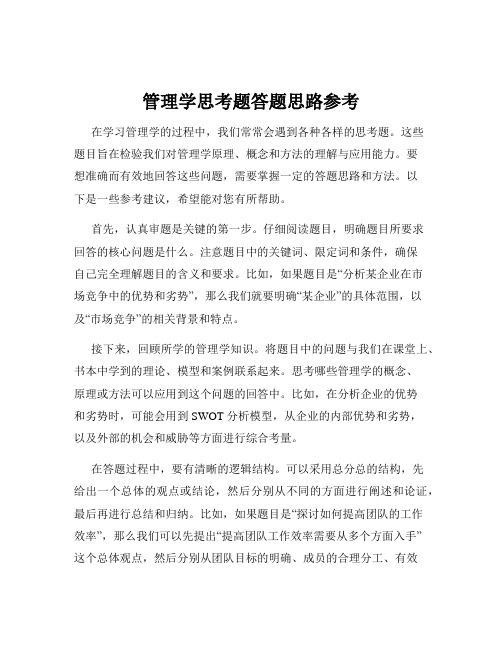
管理学思考题答题思路参考在学习管理学的过程中,我们常常会遇到各种各样的思考题。
这些题目旨在检验我们对管理学原理、概念和方法的理解与应用能力。
要想准确而有效地回答这些问题,需要掌握一定的答题思路和方法。
以下是一些参考建议,希望能对您有所帮助。
首先,认真审题是关键的第一步。
仔细阅读题目,明确题目所要求回答的核心问题是什么。
注意题目中的关键词、限定词和条件,确保自己完全理解题目的含义和要求。
比如,如果题目是“分析某企业在市场竞争中的优势和劣势”,那么我们就要明确“某企业”的具体范围,以及“市场竞争”的相关背景和特点。
接下来,回顾所学的管理学知识。
将题目中的问题与我们在课堂上、书本中学到的理论、模型和案例联系起来。
思考哪些管理学的概念、原理或方法可以应用到这个问题的回答中。
比如,在分析企业的优势和劣势时,可能会用到 SWOT 分析模型,从企业的内部优势和劣势,以及外部的机会和威胁等方面进行综合考量。
在答题过程中,要有清晰的逻辑结构。
可以采用总分总的结构,先给出一个总体的观点或结论,然后分别从不同的方面进行阐述和论证,最后再进行总结和归纳。
比如,如果题目是“探讨如何提高团队的工作效率”,那么我们可以先提出“提高团队工作效率需要从多个方面入手”这个总体观点,然后分别从团队目标的明确、成员的合理分工、有效的沟通机制、激励措施等方面进行详细的论述,最后总结强调各个方面的协同作用对于提高团队效率的重要性。
对于每个观点或论点,都要提供充分的论据和案例支持。
论据可以是理论知识、实际数据、企业案例或者个人经验等。
通过具体的例子来证明自己的观点,能够使回答更具说服力。
比如,在论述激励措施对提高团队效率的作用时,可以引用一些知名企业成功的激励案例,如谷歌的员工福利制度如何激发员工的创造力和工作积极性。
同时,要注意语言表达的准确性和简洁性。
避免使用模糊、含混或过于复杂的语言,确保自己的观点能够清晰明了地传达给读者。
尽量使用管理学领域的专业术语,但也要注意解释清楚,以免读者产生误解。
罗宾斯《管理学》(第11版)笔记和课后习题答案资料
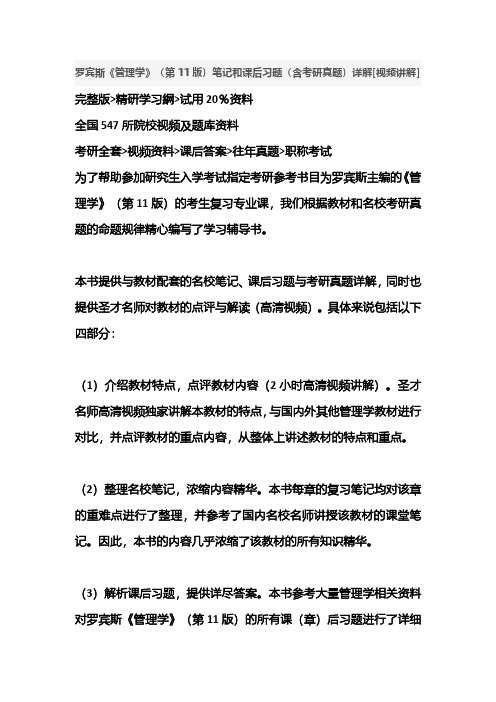
罗宾斯《管理学》(第11版)笔记和课后习题(含考研真题)详解[视频讲解]完整版>精研学习䋞>试用20%资料全国547所院校视频及题库资料考研全套>视频资料>课后答案>往年真题>职称考试为了帮助参加研究生入学考试指定考研参考书目为罗宾斯主编的《管理学》(第11版)的考生复习专业课,我们根据教材和名校考研真题的命题规律精心编写了学习辅导书。
本书提供与教材配套的名校笔记、课后习题与考研真题详解,同时也提供圣才名师对教材的点评与解读(高清视频)。
具体来说包括以下四部分:(1)介绍教材特点,点评教材内容(2小时高清视频讲解)。
圣才名师高清视频独家讲解本教材的特点,与国内外其他管理学教材进行对比,并点评教材的重点内容,从整体上讲述教材的特点和重点。
(2)整理名校笔记,浓缩内容精华。
本书每章的复习笔记均对该章的重难点进行了整理,并参考了国内名校名师讲授该教材的课堂笔记。
因此,本书的内容几乎浓缩了该教材的所有知识精华。
(3)解析课后习题,提供详尽答案。
本书参考大量管理学相关资料对罗宾斯《管理学》(第11版)的所有课(章)后习题进行了详细的分析和解答,并对相关重要知识点进行了延伸和归纳。
(4)精选考研真题,巩固重难点知识。
为了强化读者对重要知识点的理解,本书精选了部分名校的管理学考研真题,并提供了详细的答案解析,这些高校均以该教材作为考研参考书目。
所选考研真题基本涵盖了每章的考点和难点,特别注重理论联系实际,突显当前热点。
第一部分开篇导读[1小时视频讲解]第二部分笔记和课后习题(含考研真题)详解第1篇管理导论第1章管理与组织导论1.1复习笔记1.2课后习题详解1.3考研真题详解附加模块一管理史复习笔记课后习题详解考研真题详解第2章理解管理的情境:约束和挑战2.1复习笔记2.2课后习题详解2.3考研真题详解第2篇综合的管理问题第3章全球环境中的管理3.1复习笔记3.2课后习题详解第4章对多样性的管理4.1复习笔记4.2课后习题详解4.3考研真题详解第5章对社会责任和道德规范的管理5.1复习笔记5.2课后习题详解5.3考研真题详解第6章对变革和创新的管理6.1复习笔记6.3考研真题详解第3篇计划第7章作为决策者的管理者7.1复习笔记7.2课后习题详解7.3考研真题详解第8章计划的基础8.1复习笔记8.2课后习题详解8.3考研真题详解第9章战略管理9.1复习笔记9.2课后习题详解9.3考研真题详解附加模块二计划工具和技术复习笔记课后习题详解考研真题详解第4篇组织第10章基本的组织设计10.1复习笔记10.2课后习题详解10.3考研真题详解第11章适应能力强的组织设计11.1复习笔记11.2课后习题详解11.3考研真题详解第12章人力资源管理12.1复习笔记12.2课后习题详解12.3考研真题详解第13章团队管理13.1复习笔记13.2课后习题详解13.3考研真题详解第5篇领导第14章理解个体行为14.1复习笔记14.2课后习题详解14.3考研真题详解第15章管理者与沟通15.1复习笔记15.2课后习题详解15.3考研真题详解第16章激励员工16.1复习笔记16.2课后习题详解16.3考研真题详解第17章作为领导者的管理者17.1复习笔记17.2课后习题详解17.3考研真题详解第6篇控制第18章控制导论18.1复习笔记18.2课后习题详解18.3考研真题详解第19章运营管理19.1复习笔记19.2课后习题详解19.3考研真题详解附录管理创业型企业复习笔记课后习题详解考研真题详解第三部分罗宾斯《管理学》教材点评及总结[1小时视频讲解]。
2011年湖南大学考研孙耀吾管理学课程习题(带答案)

第一章管理与管理学第二章管理学的形成与发展一、填充题1. 亚当. 斯密的国富论标志着资本主义商品经济理论体系的形成,指出劳动是国民财富的源泉,经济现象是具有利己主义的人们的活动所产生的。
2.宋朝的丁渭运用管理思想,成功的高效的完成了皇城的修复工程。
4.法约尔认为,要经营好一个企业,不仅要改善生产现场的管理,而且应当注意改善有关企业经营的六个方面的职能:技术只能经营只能、财务只能、安全只能、会计只能、管理职能。
5.一个员工在任何活动中只应接受一位上级的命令,这就是法约尔提出的_统一命令原则。
6.正式组织以__效率_为主要标准,非正式组织以工作的外部环境__感情_为主要标准。
7.美国心理学家弗雷德里克·赫茨伯格于1959年提出双因素理论。
8.根据赫茨伯格的双因素理论,激励因素是以为中心的,而保健因素则与有关。
9.马斯洛的高层需要即赫茨伯格的主要激励因素,而为了维持生活所必须满足的低层需要则相当于保健因素。
10.模型按作用可分为描述型和规范型,按变量种类可分为_确定型模型_和_随机型模型_。
11.对比x理论和y理论,可以看出,它们的差别在于对于工人的_需要看法不同,因此采用的_管理方法_也不相同。
12.系统理论认为企业是由六个要素构成的,即人、物资、设备、财、任务、信息。
13.决策理论认为,企业中的决策可以分为程序性决策和非程序性决策两类。
14.威廉·大内指出了从美国式管理的组织-A型组织向采用日本式管理的组织-z型组织转变的许多措施,其核心是产业(市场)结构。
15.随着支柱进步和社会发展,企业内部组织结构正趋向方向发展。
16. 迈克尔·波特的竞争战略理论主要以分析为基础,名著《竞争战略》(1980年)把战略管理理论研究推向了高峰。
二、选择题1.“科学管理理论”的创始人是__A__。
A.泰罗B.巴贝奇C.甘特D.福特2.梅奥通过霍桑试验得出,人是__B__。
A.经纪人B.社会人C.理性人D.复杂人3. 根据赫茨伯格的双因素理论,以下属于保健因素的是哪一个__C_。
管理学答题技巧
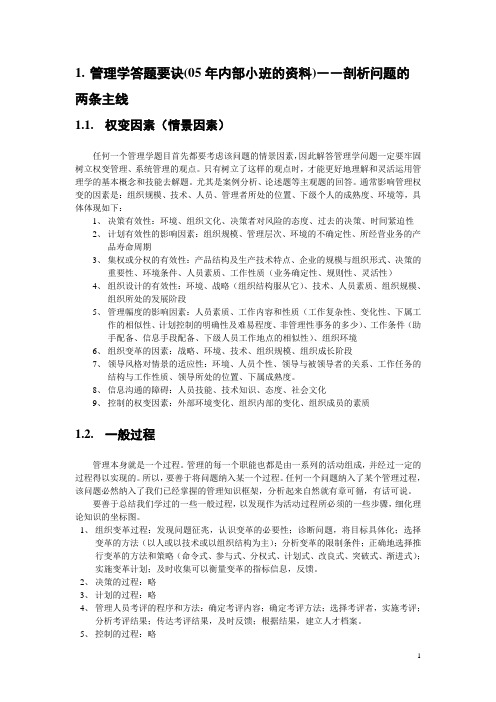
1.管理学答题要诀(05年内部小班的资料)――剖析问题的两条主线1.1.权变因素(情景因素)任何一个管理学题目首先都要考虑该问题的情景因素,因此解答管理学问题一定要牢固树立权变管理、系统管理的观点。
只有树立了这样的观点时,才能更好地理解和灵活运用管理学的基本概念和技能去解题。
尤其是案例分析、论述题等主观题的回答。
通常影响管理权变的因素是:组织规模、技术、人员、管理者所处的位置、下级个人的成熟度、环境等,具体体现如下:1、决策有效性:环境、组织文化、决策者对风险的态度、过去的决策、时间紧迫性2、计划有效性的影响因素:组织规模、管理层次、环境的不确定性、所经营业务的产品寿命周期3、集权或分权的有效性:产品结构及生产技术特点、企业的规模与组织形式、决策的重要性、环境条件、人员素质、工作性质(业务确定性、规则性、灵活性)4、组织设计的有效性:环境、战略(组织结构服从它)、技术、人员素质、组织规模、组织所处的发展阶段5、管理幅度的影响因素:人员素质、工作内容和性质(工作复杂性、变化性、下属工作的相似性、计划控制的明确性及难易程度、非管理性事务的多少)、工作条件(助手配备、信息手段配备、下级人员工作地点的相似性)、组织环境6、组织变革的因素:战略、环境、技术、组织规模、组织成长阶段7、领导风格对情景的适应性:环境、人员个性、领导与被领导者的关系、工作任务的结构与工作性质、领导所处的位置、下属成熟度。
8、信息沟通的障碍:人员技能、技术知识、态度、社会文化9、控制的权变因素:外部环境变化、组织内部的变化、组织成员的素质1.2.一般过程管理本身就是一个过程。
管理的每一个职能也都是由一系列的活动组成,并经过一定的过程得以实现的。
所以,要善于将问题纳入某一个过程。
任何一个问题纳入了某个管理过程,该问题必然纳入了我们已经掌握的管理知识框架,分析起来自然就有章可循,有话可说。
要善于总结我们学过的一些一般过程,以发现作为活动过程所必须的一些步骤,细化理论知识的坐标图。
罗宾斯管理学11版课后答案

罗宾斯管理学11版课后答案罗宾斯管理学11版课后答案【篇一:管理学罗宾斯7版课后习题解答】管理与组织导论一、谁是管理者1.管理者在哪些方面不同于非管理人员?答:协调其他人的工作——区分了管理岗位与非管理岗位。
2.说明为什么并不总能很容易地确定谁是组织中的管理员。
答:组织以及工作正在变化的性质模糊了管理者与非管理雇员之间的界限,许多传统的职位现在都包括了管理性的活动,特别是在团队中(团队成员通常要制定计划、决策以及监督自己的绩效),非管理雇员也承担着过去是管理者的一部分职责。
补充:⑴管理者:管理者是这样的人,他通过协调其他人的活动达到与别人一起或者通过别人实现组织的目标。
3.对比三种不同的管理层次。
答:①基层管理者是最低层的管理人员,他们管理着非管理雇员所从事的工作,这些工作生产和提供组织的产品。
②中层管理者包括所有处于基层和高层之间的各个管理层次的管理者,这些管理者管理着基层管理者。
③高层管理者处于或接近组织顶层,他们承担着制定广泛的组织决策、为整个组织制定计划和目标的责任。
注:并不是所有的组织都具有金字塔形的组织结构,但都需要某个人来扮演管理者的角色,即需要有人来协调工作和活动,以便能够同别人一起或者通过别人来实现组织的目标。
二、什么是管理和管理者做什么一个协调工作活动的过程,以便能够有效率和有效果地同别人一起或通过别人实现组织的目标。
要点:①过程代表了一系列进行中的有管理者参与的职能或活动,这些职能一般划分为计划、组织、领导和控制。
②协调其他人的工作——区分了管理岗位与非管理岗位。
③有效率和有效果地完成组织的工作活动。
4.如何理解管理是一个过程。
答:上面要点①。
5.定义效率和效果。
答:①效率是指以尽可能少的投入获得尽可能多的产出。
通常指的是“正确地做事”,即不浪费资源。
②效果通常是指“做正确的事”,即所从事的工作和活动有助于组织达到其目标。
③可见,效率是关于做事的方式;效果是指实现组织目标的程度,涉及事情的结果。
管理学答题技巧

一、答题规范1.名词解释:除了答出本身的定义之外,还可以从以下几方面考虑进行深入回答:该名词术语产生的原因或者背景;特征;相似或者相对的概念的类比;如关系营销与交易营销。
该名词术语对管理学学科、管理实践中的贡献、地位、影响和作用;该名词术语对企业管理实践的指导意义;缺陷及改进,发展方向前景等;适度的个人评价。
2.选择题:保准会的,做出正确答案;叫不准的,做一个标记,回头处理;完全不会的,四选一,有25%的正确率,以后就不用再这样的提上浪费时间了。
3.简答题:一般这类题中只有一道会有点难度。
需要自己总结,或者老师的论文,或者与热点挂钩。
但有个特点,它很有可能是在书中有专门的章节讲解的。
4.论述题:一分析。
本题所涉及到的观点有哪些,分析先后顺序。
二拆散。
把论述题题拆成几个简答题。
三找角度。
从是什么、为什么、怎么样的角度去组织答案。
四提炼。
如果答案较多要提炼出答案的精华内容,概括去答。
五分条。
要分条写出答案。
既不要写1-2条,也不要写的条数太多如10多条。
基本上定在2分1条。
六是扣题作答案。
最后要扣题并清楚、工整的写出论述题的正确答案。
5.案例分析题:做到通读材料,充分理解内容,不可麻痹大意;应做到审清题干,切忌匆忙下笔,答非所问;力争答全问题,杜绝归纳不全、忽略要点,东丢西漏的毛病;善于调动知识储备,或者适当的改造,冷静处理。
二、答题技巧1、名词解释一般专业考试都会有这种题目,这是安慰大家的,让大家首先对自己有信心,所以很简单。
字数要求:100左右模式要求:答:1)(重复要解释的概念)是(概念)2)特征3)某些情况下可以举例说明4)意义(概念包括内涵和外延,所以至少得把这个名词的内涵和外延解释清楚。
)收工!不要拖泥带水。
2、选择题不过大家千万别掉以轻心。
首先一定要看清楚题目,是要选择正确的项还是错误的项。
另外选择题中若有计算性质的,不妨考虑一下是否要简便的方法。
另外一个就是时间上的安排,如果只是单纯的按题目比例来安排时间的话,后面的题可能就没有太多时间了,建议最好30秒做完一道选择题。
- 1、下载文档前请自行甄别文档内容的完整性,平台不提供额外的编辑、内容补充、找答案等附加服务。
- 2、"仅部分预览"的文档,不可在线预览部分如存在完整性等问题,可反馈申请退款(可完整预览的文档不适用该条件!)。
- 3、如文档侵犯您的权益,请联系客服反馈,我们会尽快为您处理(人工客服工作时间:9:00-18:30)。
Fundamentals of ManagementReferential answers for assignmentsChapter 12 What four common activities compose the process approach to management?Briefly describe each of them.The four common activities are planning, organizing, leading, and controlling.Explain. (Please refer to page 7-8)4How does a manager's job change with his/her level in the organization?The differences are of degree and emphasis but not of activity.Managers perform planning, organizing, leading, and controlling activities, but the amount of time they give to each activity is not necessarily constant.The content of the managerial activities changes with the manager's level.(Please refer to page 10)3Is your college instructor a manager? Discuss in terms of both planning, organizing, leading, and controlling, and Mintzberg’s managerial roles.A college instructor is both an individual contributor and a manager. Planning(defines class goals, establishes plans for achieving them, and develops lesson plans), Organizing(execution and class participation), Leading(motivating students, direct the activities of others, select the most effective communication channel, or resolve conflicts) , Controlling(grading).Mintzberg’s managerial role: Interpersonal—the roles of leader and liaison.Informational—monitor and disseminator. Decisional—disturbance handler and resource allocator.(Please refer to page 7- 9)Chapter 32Under what circumstances are short-term plans preferred? Under what circumstances are specific plans preferred?Provide basic definition and applicability of them. Short-term plans (length of future commitments and the degree of variability). Specific plans (clarity and predictability).(Please refer to page 75-76)5What is a SWOT analysis?Analysis of an organization’s Strengths, Weaknesses, Opportunities, and Threats in order to identify a strategic niche that the organization can exploit.(Please refer to page 85)1Organizations that fail to plan are planning to fail. Do you agree or disagree with the statement? Explain your position.Planning provides a framework for thinking through decisions and the future. it does provide direction, measurements of progress, and a framework for judging the success or failure of a venture.(Please refer to page 72-74)Chapter 43 What is a satisficing decision? How does it differ from a maximizing decision?The concepts of satisficing decision and maximizing decision.They are based on different decision making process models (perfect rationality and bounded rationality)(Please refer to page 106 and 108-110)4How do creativity, certainty, risk, and uncertainty affect individuals when they make a decision?Creativity’s most obvious value is in helping the decision maker identify all viable alternatives; individuals can make an accurate or best decision under a condition of certainty; under a condition of risk or uncertainty, they can only make a satisficing decision.(Please refer to page 104-105)5Why do you think organizations have increased the use of groups for making decisions during the past twenty years? When would you recommend using groups to make decisions?Group decisions have many advantages. Depending on the criteria using for defining effectiveness of group decisions.(Please refer to page 114-115)Chapter 52How are authority and organization structure related? Authority and power?The definition of authority and power. Authority is part of the larger concept of power. Authority is a two-dimensional concept, while power is athree-dimensional concept.(Please refer to page 134-138)3 In what ways can management departmentalize? When should one method beconsidered over the others?Five ways to departmentalize: function, product, customer, geography, or process.The method or methods used should reflect the grouping that would best contribute to the attainmen t of the organization’s objectives and the goals of individual units.(Please refer to page 142)3 Show how both the functional and matrix structures might create conflict withinan organization.The conflict within a matrix is clear, competing and conflicting demands by different bosses on the same employee. In a functional organization, different functions and their managers can end up in competition for resources, personnel, priorities, etc., since each area is responsible for a separate function.(Please refer to page 145-147)Chapter 82 Contrast lower-order and higher-order needs in Maslow’s needs hierarchy.Lower-order needs include physiological needs and safety needs, they must be satisfied if the individual is to be healthy and secure. Higher-order needs include social needs, esteem needs and self-actualization needs, they are related to the development and achievement of one’s potential. Comparing.(Please refer to page 219)3Describe the three needs in the three-needs theory.Need for achievement; need for power; need for affiliation. Explain.(Please refer to page 222-223)5 Describe several means that you might use to motivate (1) a minimum-wageemployee or (2) professional and technical employees? Which of your suggestions do you think is best? Support your position.(1) a minimum-wage employee: money is important, but not the only reward thatpeople seek, focus on recognition program, praise and empowering(2) professional and technical employees: job challenge, organizational support oftheir work, new assignments, autonomy, training and educational opportunities, recognition(Please refer to page 234-235)Chapter 91 Discuss the strengths and weaknesses of the trait theory of leadership.The trait theory of leadership is very easy to understand. But it ignores some more important factors such as situational factors to identify effective leadership.(Please refer to page 246-247)3 How is a least-preferred coworker determined? What is the importance of one’sLPC for the Fiedler theory of leadership?The least-preferred coworker (LPC) questionnaire is to measure the leader’s behavioral orientation: either task oriented or relationship oriented. Based on the leader’s style determined by LPC, the organization can change situation to m atch it in order to attain desirable leadership performance.(Please refer to page 251-252)4Contrast the three types of trust. Relate them to your experience in personal relationships.The three types of trust are deterrence-based trust, knowledge-based trust and identification-based trust.Briefly describe each of them.(Please refer to page 267-268)Chapter 102 Why are effective interpersonal skills so important to a manager’s success?Managers get things done through others, competencies in leadership, communication, and other interpersonal skills are prerequisites to managerial effectiveness.(Please refer to page 286)4 What is conflict? Should some conflict be encouraged?Conflict-perceived incompatible differences resulting in some form of interference or opposition. Functional conflicts that support the goals of the organization are good and should be encouraged.(Please refer to page 292-293)1 “Ineffective communication is the fault of the sender.” Do you agree or disagreewith this statement? Support your position.Both sender and receiver are affected by their own bias, the sender is responsible for adapting the message for maximum fidelity in its transmission and interpretation.(Please refer to page 276-277)Chapter 112 Name four methods managers can use to acquire information about actualorganizational performance.Personal observation, statistical reports, oral reports, and written reports.(Please refer to page 310-311)4 What are the advantages and disadvantages of feed forward control?Concept of feed forward control. Advantage: prevent anticipated problems.Disadvantage: difficulty in obtaining information.(Please refer to page 314)1 How are planning and control linked? Is the control function linked to theorganizing and leading functions of management? Explain.The control process assumes that standards of performance already exist. They are created in the planning function. Objectives are the standards against which progress is measured and compared. An effective control system ensures that activities are completed in ways that lead to the attainment of the organization’sgoals. So control is linked to all functions of management, not just organizing and leading.(Please refer to page 308-310 )。
